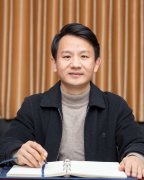戴晓明
近期热点
资料介绍
个人简历
简 历 戴晓明,博士,教授。以宽带无线通信系统理论与技术为主要研究方向,重点研究5G+/6G 关键技术,人工智能,非正交多址接入,MIMO,ASIC芯片设计等。以第一作者在国际刊物和国际学术会议上发表40余篇学术论文,其中IEEE Trans. 系列期刊(SCI)文章15篇(JCR一区及二区期刊6篇),拥有/申请30余项国内国际发明专利。曾任多个国际学术会议专题分会主席、特邀专题研讨组织者、主持人。由其提出的蜂窝系统导频设计方案被4G核心物理层标准采纳;提出图样分割多址(Pattern Division Multiple Access, PDMA)[16]被国际电信联盟(ITU)发表的“未来地面无线通信技术发展趋势”(Future Technology Trends of Terrestrial IMT Systems)白皮书列为5G潜在应用的一项关键技术[16],其在多址接入的工作[13][17]被ITU“未来地面无线通信技术发展趋势”白皮书引用;在MIMO接收机方面的研究工作被韩国Sejong大学电子工程系选作研究生文献阅读材料[18];5篇论文被欧盟第七框架计划FP7(7th Framework Program)核心项目引用;其研究工作被5G标准化组织3GPP中多篇方向性技术文稿(Way forward)引用[19]-[24]。承担过多项国家级973子专题、863课题,以及产学研等项目。目前接受华为技术,intel,中国移动研究院,中兴通讯,大唐移动,是德科技(Keysight,原安捷伦仪器),展讯通信,小米科技等公司资助开展无线通信前沿研究工作。如果您对我们的研究方向感兴趣,请与我们联系。我们热诚欢迎来自全国乃至世界各地的优秀学生及科研人员作为师资博士后,研究生等等加入。研究领域
宽带无线通信 5G+/6G 人工智能 非正交多址接入 大数据处理"科研业绩 华为技术有限公司 “5G通信关键技术研究” 负责人 中兴通讯股份有限公司“面向5G的基于稀疏编码矩阵的非正交多址研究” 负责人 电信科学技术研究院 “新型多址接入关键技术研究”北京小米移动软件有限公司 “面向5G的关键技术研究”国家自然科学基金重点项目 “时空一致性的无线接入架构与关键技术研究”项目编号61431001, 主要负责全双工干扰删除关键技术研究。 国家863计划重点项目“5G新型调制编码技术研究开发”。中国移动研究院项目“关于5G总体设计、关键技术研究及标准化-新型多址技术评估与方案设计”负责人展讯通信项目“第五代通信中新型多址方案设计” 负责人 是德科技(Keysight,原安捷伦仪器)全球大学研究项目“第五代非正交多址接入方案研究” 负责人中央高校基本科研业务项目“下一代移动通信系统(5G) 超密集组网关键技术研究”负责人"近期论文
代表性论文 [1] X. Dai, Z. Zhang, S. Chen, S.Sun and B. Bai,“Pattern Division Multiple Access (PDMA): A New Multiple Access Technology for 5G,” IEEE Wire. Commun., vol. 25, no. 2, pp. 54-60, Apr. 2018. (JCR 一区, 影响因子 8.9)[2] X. Dai, “Allele gene based adaptive genetic algorithm to the code design,” IEEE Trans. Communi., vol. 59, no. 5, pp. 1253-1259, May 2011.[3] X. Dai, Kenichi Higuchi,Z. Zhang, K. Long, et al. “Enhancing the performance of the quasi-ml receiver (detector plus decoder) for coded MIMO systems via statistical information,” IEEE Trans. Vehi. Techno., vol. 65, no. 5, pp. 3765 - 3771, June. 2016.[4] X. Dai, R. Zou, S. Sun, and Y. Wang, “Reducing complexity of quasi-maximum-likelihood detectors through companding for coded MIMO systems,” IEEE Trans. Vehi. Tech., vol. 61, no. 3, pp. 1109-1123, Mar. 2012.[5] X. Dai, Kenichi Higuchi,Z. Zhang, K. Long, S. Sun, and Y. Wang, “Enhancing the performance of the quasi-ML receiver (detector plus decoder) for coded MIMO systems via statistical information,” IEEE Trans. Vehi. Tech., vol. 65, no. 5, pp. 3765 - 3771, June. 2016.[6] X. Dai, Z. Zhang, K. Long, S. Sun, and Y. Wang, “Unequal error correcting capability aware iterative receiver for (parallel) turbo coded communications,” IEEE Trans. Vehi. Tech., vol. 63, no. 7, pp. 3446-3451, Sep. 2015.[7] X. Dai, H. Zhang, and Y. Wang, “New sequence design criteria for multipath channels,”IEEE Trans. Vehi. Tech., vol. 58, no. 8, pp. 4149-4158, Oct. 2009.[8] X. Dai, R. Zou, S. Sun, and Y. Wang, “Reducing complexity of quasi-ML detectors through simplified branch metric and accumulated branch metric based detection,” IEEE Communi. Lett. vol.17, no. 5, pp. 916-919, May 2013.[9] X. Dai, “Enhancing the performance of the SIC-MMSE iterative receiver for coded MIMO systems via companding,” IEEE Communi. Lett. vol. 16, no. 6, pp. 921-924, June. 2012.[10] X. Dai, R. Zou, S. Sun, and Y. Wang, “Transceiver impairments on the performance of the LMMSE-PIC iterative receiver and its mitigation,” IEEE Communi. Lett. vol. 17, no. 8, pp. 1536-1539, 2013.[11] X. Dai, S. Sun, and Y. Wang, “Reduced-complexity (quasi-)maximum-likelihood detectors with no performance degradation for S-QAM modulated MIMO systems,” Wire. Pers. Communi., vol. 66, no. 4, pp. 613-6273, Oct. 2012.[12] X. Dai “Successive interference cancellation amenable space-time codes with good multiplexing-diversity tradeoff,” Wire. Pers. Communi., vol. 55, no. 4, pp. 645-654, 2010.[13] X. Dai “Successive interference cancellation amenable space-time codes with good multiplexing-diversity tradeoff,” Wire. Pers. Communi., vol. 55, no. 4, pp. 645-654, 2010.[14] X. Dai, S. Sun, and Y. Wang, “Reduced-complexity performance-lossless (quasi-) maximum -likelihood detectors for S-QAM modulated MIMO Systems,” Electronics Lett., vol. 49, no. 11, pp. 724 -725, May 2013[15] X. Dai, Shanzhi Chen, Shaohui Sun, et. al “Successive interference cancelation amenable multiple access (SAMA) for future wireless communications,” (invited paper) in Proc. IEEE ICCS, pp. 222-226, Nov. 12-15, 2014.[16] http://www.itu.int/dms_pub/itu-r/opb/rep/R-REP-M.2320-2014-MSW-E.docx[17] X. Dai, S. Sun, and Y. Wang, “Successive interference cancellation amiable space-time codes with good multiplexing-diversity tradeoff,” (invited paper) IEEE APCC 2009, pp. 237-240, Oct. 15-18, 2009.[18] http://sdc.sejong.ac.kr/Courses/Board/Data/201121_w_comm/Low%20Complexity%20Maximum-Likelihood%20Based%20QRD-M%20for%20MIMO%20Systems%20with%20S-QAM%20or%20APSK_(upload).pdf[19] 3GPP, R1-162226, “Receiver Details and Link Performance for MUSA , ZTE Microelectronics,”[20] 3GPP, R1-162226,Performance analysis on the effect of spreading signature matrix in 5G NR multiple access schemes, Spreadtrum Communications,http://www.3gpp.org/ftp/TSG_RAN/WG1_RL1/TSGR1_86/Docs/R1-167002.zip[21]3GPP, R1-162226, Discussion on multiple access for new radio interface, ZTE http://www.3gpp.org/ftp/tsg_ran/WG1_RL1/TSGR1_84b/Docs/R1-162226.zip[22] 3GPP, R1-1608755, LLS results of PDMA with realistic channel estimation, CATThttp://www.3gpp.Org/ftp/tsg_ran/WG1_RL1/TSGR1_86b/Docs/R1-1608755.zip[23] 3GPP, R1-164247, Performance of LLS of PDMA, CATThttp://www.3gpp.org/ftp/tsg_ran/WG1_RL1/TSGR1_86b/Docs/R1-1608756.zip[24] 3GPP, R1-164247, Performance of LLS of PDMA, CATThttp://www.3gpp.org/ftp/tsg_ran/WG1_RL1/TSGR1_85/Docs/R1-164247.zip[25] Xiaohui Sun, Dandan Zhang, X. Dai, “Performance Analysis of Full-Duplex Based Two-Way Relaying” China Communi.,vol.13, no.11, pp.35-48, Dec.2016(*corresponding author)[26] Zhuang, Jintao Li, Weibiao Geng, X. Dai, “Duplexer design for full-duplex based wireless communications,” China Communi.,vol.13, no.11, pp.1-13, Dec.2016 (*corresponding author)[27] Zhenyu Zhang, Juan Wu , Xinli Ma, Yuanyuan Dong , Yingmin Wang, Shanzhi Chen, X. Dai; “Reviews of Recent Progress on Low-Complexity Linear Detection Via Iterative Algorithms for Massive MIMO Systems” 2016 IEEE/CIC International Conference on Communications in China(ICCC Workshops) pp.1-6, Jul.27-29,2016 (*corresponding author)[28]Xinyu Gao, Linglong Dai, Yuan Zhang, Tian Xie, X. Dai, and Zhaocheng Wang; “Fast Channel Tracking for Terahertz Beamspace Massive MIMO Systems” IEEE Trans. Vehi. Tech. vol. pp, no.99, pp.1-10, Oct.2016[29] Tian Xie; Linglong Dai, Xinyu Gao, X. Dai, Youping Zhao “Low-Complexity SSOR-Based Precoding for Massive MIMO Systems,”IEEE Communi. Lett., vol. 20, no. 4, pp. 744-747, 2016.[30] Bin Zhong, Jiajia Zhang, Qian Zeng, X. Dai, “Coverage Probability Analysis for Full-Duplex Relay Aided Device-to-Device Communications Networks,” China Communi.,vol.13,no.11 pp.60-67,Dec.2016 (*corresponding author)Bin Ren, Yingmin Wang, X. Dai, Kai Niu, Wanwei Tang, “Pattern matrix design of PDMA for 5G UL applications,” China Communi.,vol.13, no.2, pp.1-13, Feb.2016[31] Bin Ren, Yingmin Wang, X. Dai, Kai Niu, Wanwei Tang, “Pattern matrix design of PDMA for 5G UL applications,” China Communi.,vol.13, no.2, pp.1-13, Feb.2016 [32] X. Dai, S. Sun, and Y. Wang, “Shedding new light on sequence design criteria for multipath channels,” in Proc. ICC, 2009, Dresden, Germany, pp. 1-6.[33] X. Dai, “Low-complexity maximum-likelihood-based QRD-M for MIMO systems with S-QAM or APSK,” IEEE ICC 2010, Cape Town, South Africa, pp.1-6.[34] Jin Xu, X. Dai, and Weiguo Ma, “A component-level soft interference cancellation based iterative detection algorithm for coded MIMO systems,” in Proc. IEEE VTC2014 Fall, pp. 14-17, Sep 12-15, 2014[35] X. Dai,S. Sun, and Y. Wang, “Two high-rate space-time codes for three and four transmit antennas with good diversity-multiplexing tradeoffs,” ICST CHINACOM 2010, pp.1-6, Sep. 12-14, 2010.[36] Bin Ren, Xinwei Yue, Wanwei Tang, Yingmin Wang, Shaoli Kang, X. Dai, “Advanced IDD receiver for PDMA uplink system” 2016 IEEE/CIC International Conference on Communications in China (ICCC Workshops) pp.1-6, Jul.27-29,2016[37] henyu Zhang, Yuanyuan Dong, Zhongshan Zhang, Xiyuan Wang, Xiaoming Dai, Linglong Dai and Haijun Zhang, \IMT-2020 (5G) 非正交传输组副组长 中南大学兼职研究生导师标签: 北京科技大学 计算机与通信工程学院
相关热点

